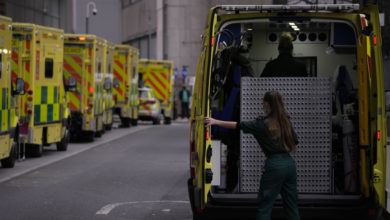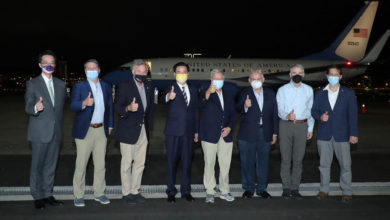Test to Treat Program Won’t Solve the COVID-19 Drug Problem

OOn March 1, President Joe Biden promised a lot to Americans. Biden proudly declared in his State of the Union address that he is launching a program which will allow anyone who has been tested positive for COVID-19 access to the most recent approved drugs to combat the virus.
“We’re launching the “Test to Treat” initiative so people can get tested at a pharmacy and, if they prove positive, receive the antiviral pills on the spot at no cost,” he said. Biden promised that the supplies of antiviral pills would increase at all pharmacies in the country, starting mid-March. This will help realize the vision of COVID-19 on-the-spot treatment.
Although the drugs have been distributed to states already, the next steps to getting the drug to those who could benefit the most are more complex.
The September 2021 regulatory amendment allows pharmacists in the United States to issue COVID-19 treatment prescriptions and also to give COVID-19 vaccine. But the U.S. Food and Drug Administration (FDA) emergency use authorizations (EUAs) for Paxlovid (Pfizer’s antiviral treatment) and molnupiravir (made by Merck and Ridgeback Therapeutics) specified that they could only be prescribed by physicians, advanced practice nurses, and physician assistants licensed to dispense antivirals. A small number of retailers have licensed pharmacists who are able to write prescriptions for COVID-19 therapies.
In other words, while the Test to Treat program is well-intentioned, it’s not really addressing the true barriers to treatment for many of those who need it the most: those who don’t have a primary care physician or aren’t getting regular checkups at clinics or hospitals and who rely on pharmacies for treating everything from flu to strep throat to, now, COVID-19. If people test positive at a pharmacy that doesn’t have a prescriber on staff, then they still have to either make an appointment with a primary care physician, or go to an urgent care center or clinic to be evaluated. To be effective, the medication must be administered within the first few days after symptoms are present.
Learn more An Online Pharmacy sold Millions of dubious COVID-19 drugs
Of Walgreens’ 1,300 locations that currently stock COVID-19 antiviral medications, for example, only 250 have health providers on site who can prescribe them. Walgreens is a partner with VillageMD. VillageMD has many clinics located near the pharmacy. In such cases, people who test positive and might need a COVID-19 antiviral prescription “wouldn’t have to physically leave the location,” says Dr. Clive Fields, chief medical officer of VillageMD. “They would go to the pharmacist, get tested, then walk 15 steps to the comprehensive primary care office, get evaluated, and if the antiviral is appropriate, get a prescription and literally pick it up without walking out of the location.”
That’s the ideal scenario that Biden laid out in the State of the Union, but it’s not possible in most of the nation’s pharmacies. While nine out of 10 Americans live within five miles of a pharmacy, if they can’t be seen by a medical provider and receive a prescription for an antiviral on site, then the Test to Treat program loses much of its disease-curbing power. “The idea of somebody coming into a pharmacy to get tested, then calling a doctor to see if they can make an appointment in three or four days doesn’t make sense,” says Fields. “It’s bad for the patient, bad for the community and bad for everybody the patient comes in contact with.”
Some experts say that the program does have the potential, however, to achieve what Biden hopes, and more—if it is linked to the at-home tests that the government is providing to every American household. It’s a matter of using the tools we have to fight the virus in a more coordinated and intentional way.
How do you treat COVID-19?
The COVID-19 epidemic is not ending, although it appears to be waning. However, new variations and subvariants are always possible, so protecting the public from being sick should still be a top priority. That means continuing to administer vaccines and booster shots—but these aren’t foolproof, so a certain percentage of vaccinated people will still get infected, and some of those will get seriously ill. For them, drug treatments could mean the difference between days battling flu-like symptoms at home, and weeks in the hospital—potentially in the Intensive Care Unit.
FDA approved first antiviral treatment for COVID-19 in October 2020. Remdesivir is an antiviral which makes it harder for SARS/CoV-2 to create more viruses and infect others healthy cells. It is not available as an IV, so it must be administered to patients at an infusion center or hospital. Studies also show that it’s only moderately effective, reducing serious adverse events associated with COVID-19 by about 30% among those taking it within days of symptoms appearing compared to those who don’t.
Over a year later in December 2021 the FDA issued an EUA to Paxlovid for its first COVID-19 antiviral medication, Paxlovid. This also prevents SARS-CoV-2 replicating. Pfizer studies that showed that these pills could lower the risk of being hospitalized by nearly 90% in the most vulnerable patients to the disease led the agency to approve the drug. The agency issued an EUA just one day later. Molnupiravir was another antiviral, which prevents SARS/CoV-2 making additional copies. After encouraging early data, researchers found that molnupiravir wasn’t as effective as they had hoped, lowering the risk of hospitalization and death by only about 30% among those at highest risk of disease.
For now, all antiviral treatment are not approved for patients at high risk or who may need hospitalization. They are not meant to prevent infection in the first place, and are only meant to be taken within a few days of when symptoms first appear—the short window when the virus is busy pumping out copies of itself, before it builds up and enters the lungs and other organs.
The FDA approved other COVID-19 therapy to be used in cases of infection. But unlike antiviral treatments,, monoclonal antibodies come in IV, and not pill form, so they aren’t available at pharmacies but only at infusion centers or hospitals. The monoclonal antibodies neutralize any virus floating around by soaking them up so the virus can’t attach to and infect healthy cells. FDA has approved only four treatments for this purpose. But, SARS CoV-2 could easily become mutated to bypass antibodies. The National Institutes of Health currently advises doctors not to prescribe two of them because they aren’t effective against Omicron. Only Evushield, from AstraZeneca, and GlaxoSmithKline’s Xevudy, (which, interestingly, was developed from the immune cells of an early COVID-19 patient), continues to block Omicron.
Are there any COVID-19-related treatments available?
U.S. government purchased bulk drug treatment and now distributes them via the Federal Pharmacy Program. Retail pharmacies have the option to apply and get the drugs direct through the Federal Pharmacy Program and the Test to Treat Program. Both programs allow people to receive the drugs free of cost or reimbursed by their insurance.
Through its HHS Coordination Operations and Response Element, (HCORE), the Department of Health and Human Services, has coordinated most of the many thousands of COVID-19-related treatments. Sometimes, HCORE provides advice to states on where they should send the supplies. For example, Indiana has announced that the government is sending drug directly to Walgreens and CVS locations. These clinics are where doctors can prescribe drugs for those who have tested positive. Facilities can also apply for drugs in other situations: Minnesota pharmacies, long-term care facilities, and others who want to dispense the drug and are familiar with the providers that can prescribe it, can request them from the federal government.
Learn more How the U.S. Failed Its Initial Vaccine Rollout
According to Dr. Michael Ganio of the American Society of Health System Pharmacists, current access levels are inequitable and limited. “A lot of these clinics [to which the government is sending doses] are scattered around metro areas, and don’t include a lot of medically underserved communities or rural areas,” he says, where such one-stop-shopping for testing and treatments could be most powerful.
While the amount of supply is growing, it is only increasing at a slow pace. Pfizer stated in Jan. that it was increasing its initial order of 10,000,000 doses of its therapy. This will continue until June. An additional 10,000,000 doses are expected to arrive by July. In September, Pfizer added another 10 Million doses. In order to lower the chance of anyone with COVID-19 becoming seriously ill, doctors expect to increase their ability to prescribe the treatment to more patients.
However, it is difficult for pharmacies to deliver the medications. And increasing supply still doesn’t allow pharmacists to prescribe the medications. “Supply is not the issue compared to two months ago,” says Rina Shah, group vice president of pharmacy operations and services at Walgreens. “I would say we have dispensed about 10% of the antivirals available to us.”
Biden’s Test to Treat program didn’t address the restrictive prescribing requirements in the EUA for COVID-19 antivirals. While the law passed last fall allows pharmacists to administer COVID-19 medications, and expedites people’s access to them, the FDA specifically limited prescribing of Paxlovid and molnupiravir to licensed health care providers because of concerns about drug-drug interactions and side effects. Paxlovid may lead to kidney issues so patients with kidney disease must be watched for signs and symptoms. Molnupiravir is not recommended for pregnant women because it can harm the unborn foetus. FDA determined that doctors and licensed professionals should assess patients for such risks before prescribing any drugs. However, pharmacists claim that they have the training to evaluate patients for drug interactions or side effects.
“Assessing and dispensing antivirals are in our wheelhouse,” says Shah. “In every pharmacy, this is what we do every day. We feel there is a really big opportunity in front of us to make a shift in the EUA language to impact hospitalization because we have the technology, talent, and expertise, and the ability to get into every community across the country to increase access to care that much more quickly.”
How to get the best out of Test to Treat
Some experts in public health believe that the Test to Treat program and the at-home rapid test could be a way to shift the course of COVID-19. This would allow individual patients to receive treatment without the risk of spreading the virus to the rest of the community. In theory, it should be possible to eliminate in-person visits completely.
One way to test yourself at home is via telehealth. The provider will verify and evaluate the result and ask about your medical history as well as current medication usage. If the person qualifies, then that provider can write a digital prescription, send it to a pharmacy, and that pharmacy can deliver the antiviral directly to the patient’s home, all without the infectious patient visiting a pharmacy or a health center where they might spread the virus to others.
“All of a sudden, you can massively decrease barriers to people getting treated for COVID-19,” says Dr. Michael Mina, formerly of Harvard School of Public Health and now chief science officer at eMed, a health software company that sells at-home rapid COVID-19 tests and provides telehealth experts to help people validate and interpret those results. “We’ve put tests into everyone’s homes. Now let’s link those tests to telemedicine and treatment so people can get a home test, get a lab report based on that home test, and then send that lab result to a physician who can prescribe a treatment,” he says. “Technically the whole process should be that you wake up with symptoms, get tested, and have a prescription delivered to you from your pharmacy all in under an hour.”
Mina believes that this should be Test to Treat’s ultimate goal. There’s no reason people who are potentially infectious should have to physically go into a pharmacy to get tested, and then sit around waiting for their prescription to be filled if there is an on-site provider who can prescribe them drugs available—or worse, be sent away if there isn’t. Mina, who contributed to the White House’s National COVID-19 Preparedness Plan released in March 2022, sees the federal government shifting its public health priorities from those oriented towards society as a whole to those that help individual people protect themselves from infection. This makes perfect sense. As the urgency of dealing with a rapidly-moving disease decreases, it is more crucial to make sure that people infected get treated promptly. That way, there will be fewer people who can spread the virus—to their friends, family, communities, and health care workers.
“The more that people get tested because they might want treatment, then that will keep them out of the hospital,” says Mina. “If we can do it right, all of a sudden, COVID-19 becomes a smaller issue for society.”
Read More From Time





